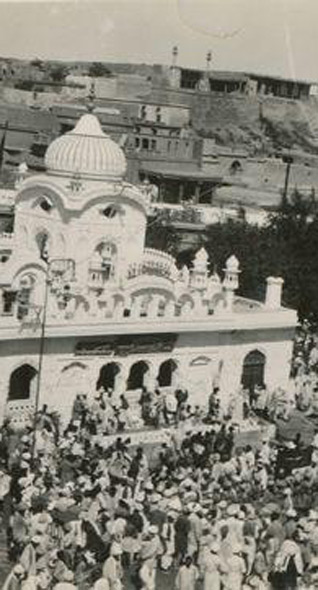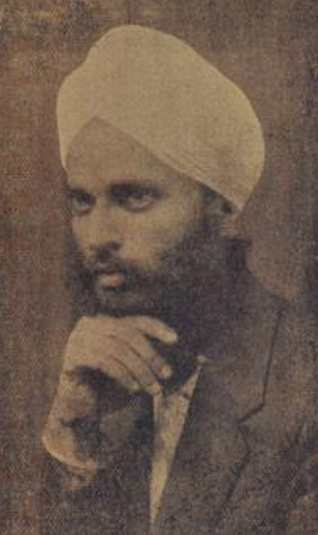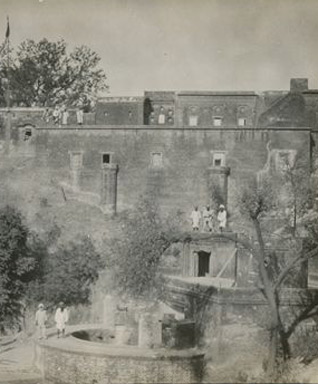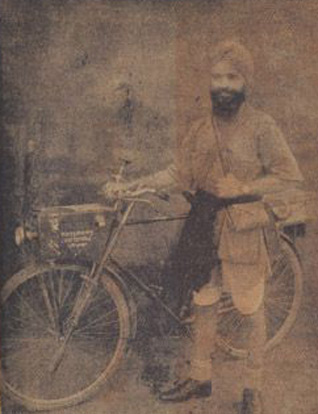
Above: Gurdwara Punja Sahib, Hassan Abdal, Punjab (now in Pakistan), 1932. Below: Gurdwara/Fort Anandgarh, Anandpur Sahib, Punjab, 1934.



Travel
He Chronicled Gurdwaras In The 1930s:
Dhanna Singh, Photographer
CHITLEEN KAUR SETHI
Some stories can only begin with “once upon a time” -- like this little-known history of an indefatigable pilgrim, Dhanna Singh ‘Patialvi’, who travelled to every historical gurdwara in pre-Partition Punjab and the subcontinent on his humble bicycle in the 1920s and 1930s, clicking pictures and chronicling his travels.
When his lost legacy -- eight diaries and more than 200 pictures -- came up for preservation at the Punjab Digital Library (PDL) in Chandigarh, Dhanna Singh returned to life, 85 years later, to tell the story of the gurdwaras as they stood in that bygone era. While many of these gurdwaras are big centres of the Sikh faith today, some have lingered on the margins and a few remain unknown.
What we know about Dhanna Singh is from his diaries and a brief mention in The Sikh Encyclopedia.
Born as Lal Singh Chahal in the early 1890s at Ghannauri village of Sangrur district, Punjab, he grew up in an orphanage with his brother and later served the royal family of Patiala, taking care of the cars of Maharaja Bhupinder Singh.
“The royal family records would have some details on him,” said PDL head Davinder Pal Singh.
He took Amrit as Dhanna Singh at Nanded in his thirties, and then he quit royal service to feed his hunger for travel. A devout Sikh, he bicycled to every gurdwara on the subcontinent, starting in the 1920s with a trip to Uttar Pradesh, Bihar, Bengal and Assam. Newspapers published the accounts of what he saw.
From Wazirabad, he came to Gujarat on April 6, 1932. His first photograph is of Takht Damdama Sahib (dedicated to the Sixth Guru Sahib), where he stopped on his way from Kashmir; the second of a gurdwara in the northeast of Gujarat linked to Guru Hargobind; and the third of Shaheedi Gurdwara Fatehsar, north of Gujarat, where Dhanna Singh reports that “the Sikhs saved 17,000 Hindus from the cruel Muslim forces” -- the entry translated by Mannat, a volunteer at PDL.
“Dhanna Singh wished the world to see these places too. So he bought a camera, an expensive proposition in those times, and learnt photography before starting his next journey -- across undivided Punjab, Jammu and Kashmir and what is now Pakistan,” said digital library head Davinder Pal Singh.
Visiting various Sikh shrines and historical places, Dhanna Singh took several hundred photos, which he captioned, dated and signed meticulously, as his gift to posterity.
He called himself “cycle yatru” and he appeared in pictures with his ride twice in the 1935 edition of ‘Phulwari’, a popular magazine of that time, which recounts one of his trips to the hills.
The same year, it reported that Dhanna Singh, who had logged 25,000 miles on his bicycle by then, had been killed by a freak gunshot.
The Sikh Encyclopedia reports that while travelling to the North Western Frontier Province (NWFP), he halted at Hasokhel village near Mir Ali in Bannu district, now in Pakistan.
"It was a common practice for the people in that disturbed area to keep loaded weapons by their side at night. Next morning, as the host was unloading his gun, it went off, killing Dhanna Singh on the spot.”
His earlier travel notes were safe in the custody of one Seva Singh, son of the late mistri Gurbaksh Singh of Patiala, but his photographs were lost, until a family, which wishes to remain anonymous, brought these to the languages department in Patiala. The family said he had left the works with a friend for safekeeping before setting out on the final picture pilgrimage.
[Courtesy: The Hindustan Times. Edited for sikhchic.com]
December 24, 2015
Conversation about this article
1: Amarjit Singh Chandan (London, United Kingdom), December 24, 2015, 3:16 PM.
Bhai Dhanna Singh was a great photo documentarian of modern Punjab. A decade before him there was another gurughar-premi, Lala Mehar Chand of Bhera, district Shahpur, who took many photographs of the brutalities of British government's operator "BT"(Beaty) in the Guru ka Bagh agitation. His photographs and eyewitness accounts were published in the Madan Mohan Malvia Report. I hope one day our two pioneer photographers will be given their deserving place in history. The Punjab Digital Library is doing a great job in preserving the shared heritage of Punjab.


